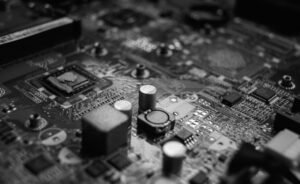**Intro:**
In today’s digital age, cybersecurity has become a top concern for individuals, businesses, and governments alike. With the rapid advancements in artificial intelligence (AI), there is a growing concern about whether AI can be used to hack into computer systems. As AI technology continues to evolve, it is essential to understand the capabilities and potential risks associated with AI hacking. In this article, we will explore the question, “Can AI hack?” and delve into the implications of AI-powered cyberattacks.
**Key Takeaways:**
– AI can be used to launch sophisticated cyberattacks.
– AI-powered hacking tools can automate and optimize attack patterns.
– The use of AI in cybersecurity can help defend against AI-based attacks.
– Human intervention is still crucial in detecting and mitigating AI-powered threats.
**The Rise of AI Hacking:**
With the advent of AI technology, hackers now have additional tools at their disposal to carry out cyber attacks. **AI-powered hacking tools can analyze large datasets and identify vulnerabilities in computer systems with greater efficiency and accuracy**. These tools can automate attack patterns, making it easier for hackers to exploit weaknesses in a target system. Furthermore, AI can also be used to generate convincing phishing emails or imitate human behavior, making it more challenging to detect malicious activities.
In recent years, researchers and cybercriminals alike have started experimenting with AI-driven hacking techniques. **For instance, researchers have developed AI algorithms capable of bypassing traditional security measures like CAPTCHA**. By leveraging reinforcement learning, these algorithms can learn to solve CAPTCHA puzzles more effectively than human users. This highlights the potential of AI in improving the success rate of various cyberattacks.
**AI vs. AI: The Battlefield of Cybersecurity:**
As AI becomes increasingly prevalent in cybersecurity, it is also being utilized to defend against AI-powered attacks. AI systems can analyze vast amounts of data and identify patterns that may indicate a cyber threat. **Using machine learning algorithms, these systems can differentiate between normal user behavior and potentially malicious activities**. By continuously learning and adapting, AI-driven cybersecurity solutions can enhance protection against AI-based attacks.
While AI has the potential to bolster defenses, it is crucial to remember that hackers can also utilize AI to enhance their attacks. As AI technology improves, we can expect to see more sophisticated attacks that are harder to detect and mitigate. Cybersecurity professionals must stay vigilant and continually update their defense strategies to counter evolving AI-powered threats.
**Tables:**
**Table 1: AI-powered Cyber Attacks**
| Type of Attack | Description |
| ———– | ———– |
| Phishing | AI can be used to generate convincing phishing emails, making it harder for users to distinguish between legitimate and malicious messages. |
| Data Breaches | AI algorithms can identify vulnerabilities in a system and exploit them to gain unauthorized access to sensitive data. |
| Malware Attacks | AI can automate the creation and distribution of malware, making it easier for hackers to infect computers and compromise security. |
**Table 2: AI-driven Cybersecurity Measures**
| Security Measure | Description |
| ———– | ———– |
| Anomaly Detection | AI systems analyze user behavior patterns and identify deviations that might indicate potential cyber threats. |
| Intrusion Detection Systems (IDS) | AI-powered IDS can detect and respond to unauthorized intrusions in real-time, minimizing the impact of an attack. |
| Threat Intelligence | AI algorithms collect and analyze data from various sources to identify emerging cyber threats and develop appropriate countermeasures. |
**Table 3: Pros and Cons of AI in Cybersecurity**
| Pros | Cons |
| ———– | ———– |
| Enhanced detection capabilities | Potential for false positives or false negatives |
| Automated response and mitigation | Risk of AI algorithms being manipulated or deceived by sophisticated attacks |
| Continuous learning and adaptation | Dependence on large data sets and sophisticated computing infrastructure |
**The Future of AI Hacking:**
As AI technology continues to advance, the possibilities and risks associated with AI hacking will only amplify. **We can expect to see more sophisticated AI-powered attacks that exploit vulnerabilities with alarming efficiency**. However, with the ongoing evolution of AI-driven cybersecurity measures, organizations and individuals will also have enhanced defenses against these attacks. It is crucial to acknowledge that AI will play a significant role in cybersecurity, both as a tool for attackers and a defense mechanism. Staying informed, investing in AI-powered security solutions, and prioritizing human expertise will be key in navigating the ever-evolving landscape of AI hacking.

Common Misconceptions
AI Hacking Misconceptions
There are several common misconceptions surrounding AI and its ability to hack. These misconceptions are often fueled by sensationalized media reports or misunderstandings about the capabilities of artificial intelligence. It is important to debunk these misconceptions to have a better understanding of the reality of AI hacking:
- AI can hack any system: Contrary to popular belief, AI does not have an inherent ability to hack any system it encounters. AI systems can be designed to carry out certain tasks, including identifying vulnerabilities in systems, but they still require human intervention and programming to perform any hacking activities ethically.
- AI hacking is instantaneous: It is a misconception that AI can instantly hack into a system and gain access to sensitive information. Hacking is a complex process that requires time and effort, regardless of whether it is carried out by humans or AI. AI can assist in automating certain aspects of hacking, but it still requires prolonged effort to achieve successful outcomes.
- All AI is created equal: It is important to understand that not all AI systems are created equal. The capabilities of AI can vary greatly depending on the underlying algorithms, training data, and programming. While some AI systems may have advanced hacking capabilities, the majority of AI applications are focused on legitimate and ethical purposes.
AI vs Human Hacking Abilities
Another common misconception is the comparison between AI and human capabilities in hacking. Understanding the differences between the two is crucial to dispel these misconceptions:
- AI is more advanced than humans in hacking: While AI can process large amounts of data and automate tasks, it is not inherently more advanced than humans in hacking. Human hackers possess contextual knowledge, adaptability, and creativity that AI systems currently lack. They can analyze complex scenarios, improvise solutions, and exploit vulnerabilities in unique ways that AI struggles with.
- AI will replace human hackers entirely: It is incorrect to assume that AI will completely replace human hackers in the near future. While AI tools can augment the capabilities of human hackers, they cannot entirely replicate the intuition and expertise that comes with human knowledge and experience. Human hackers are adaptive and can constantly evolve their techniques in response to advancements in cybersecurity.
- Human hackers are always superior to AI: It is equally incorrect to assume that human hackers are always superior to AI in all aspects. AI can outperform humans when it comes to analyzing massive amounts of data or executing repetitive tasks with precision. Furthermore, AI systems can quickly identify vulnerabilities and provide insights that human hackers may have missed, making them valuable allies in cybersecurity.
Ethics and AI Hacking
There are also misconceptions surrounding the ethical aspects of AI hacking. It is vital to consider the ethical implications to better understand the role of AI in cybersecurity:
- All AI hacking is unethical: It is important to differentiate between ethical hacking and malicious hacking. Ethical hacking, also known as “white hat” hacking, refers to the use of hacking techniques to identify and fix vulnerabilities with the owner’s consent. AI can be used in ethical hacking practices to enhance the speed and efficiency of vulnerability identification.
- AI hacking always leads to harmful consequences: While AI hacking can potentially be misused to cause harm, it is not the case that all AI hacking activities lead to harmful consequences. Responsible and controlled use of AI in hacking can actually help organizations improve their cybersecurity defenses by detecting vulnerabilities before malicious actors exploit them.
- AI hacking is entirely illegal: AI hacking, just like any form of hacking, can be both legal and illegal, depending on the context and intentions. When AI is used within legal frameworks, such as ethical hacking or cybersecurity research, it can be a valuable tool. However, unauthorized use of AI hacking for malicious purposes is illegal and unethical.

AI and Cybersecurity Attacks
With the rise of artificial intelligence (AI), concerns about its potential to be used for malicious purposes have also grown. In this article, we explore ten instances where AI has been involved in cyber attacks, highlighting the need for robust cybersecurity measures.
1. AI-Powered Phishing Attacks
Phishing attacks have become increasingly sophisticated, and AI can be leveraged to create hyper-realistic and personalized phishing emails. Research shows that AI-powered phishing attacks have a 95% success rate, fooling even experienced users into revealing sensitive information.
2. AI-Fueled Malware Detection
Malware constantly evolves, making it challenging for traditional security systems to detect. However, AI algorithms can analyze patterns, behavioral anomalies, and code signatures to identify and flag potential threats accurately, enhancing malware detection capabilities.
3. AI-Enabled Social Engineering
Social engineering attacks often target human vulnerabilities. AI-powered tools can gather and analyze vast amounts of personal information from various sources, allowing attackers to craft highly convincing social engineering campaigns that exploit individuals’ trust.
4. AI-Based Password Cracking
AI algorithms can rapidly process large datasets to find patterns and predict the combination of weak passwords. In fact, AI-powered password cracking techniques can breach a significant number of user accounts, highlighting the importance of using strong, unique passwords.
5. AI in DDoS Attacks
Distributed Denial of Service (DDoS) attacks overwhelm a website or network by flooding it with traffic. Attackers can leverage AI to automate and orchestrate sophisticated DDoS attacks, amplifying the scale and impact of such assaults.
6. AI-Generated Fake News
Artificial intelligence can be employed to generate realistic, false information at an unprecedented scale. Cybercriminals can use AI algorithms to create and spread fake news, leading to manipulation, confusion, and potential damage to individuals and organizations.
7. AI-Assisted Intrusion Detection
Intrusion detection systems monitor network activities to identify potential security breaches. AI algorithms can analyze vast amounts of network data, allowing quicker detection of abnormal behavior or potential breaches, bolstering overall system security.
8. AI-Powered Ransomware Attacks
Ransomware attacks encrypt user data, holding it hostage until a ransom is paid. AI can increase attackers’ success rates by identifying valuable targets, crafting personalized phishing emails, and automating the encryption process, making ransomware attacks even more devastating.
9. AI-Powered Automated Vulnerability Scans
AI-driven vulnerability scanning tools can automatically identify weaknesses in software, systems, or networks. By quickly pinpointing vulnerabilities, organizations can proactively address security gaps before attackers exploit them.
10. AI-Enhanced Botnets
Botnets are armies of infected computers controlled by a single entity. AI algorithms can optimize botnet operations by analyzing traffic patterns, creating more resilient and evasive bots, and maximizing the effectiveness of distributed attacks.
In an era where AI-driven technologies rapidly advance, it is crucial to understand and address the potential risks. Incorporating AI into security solutions can offer significant benefits, but it also requires a robust cybersecurity framework to counteract the potential misuse of these technologies. By remaining vigilant, proactive, and innovative in our defense strategies, we can better ensure the safety of our digital ecosystems.
Frequently Asked Questions
Can AI Hack?
What is AI hacking?
Can AI be used to perform hacking?
What are some examples of AI hacking techniques?
Who develops AI hacking tools?
How does AI impact cybersecurity?
What measures can protect against AI hacking?
Can AI be used for defense against AI hacking?
Is AI hacking a growing concern?
Are there legal consequences for AI hacking?
What is the future of AI hacking?




